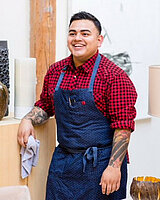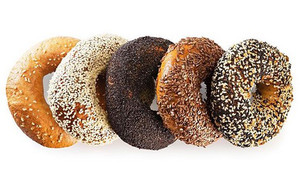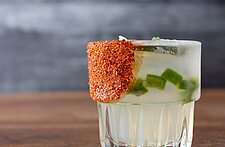 Fusion cooking — the combination of different ethnic cuisines’ recipes, ingredients and techniques — often gets a bad rap in the food world. What Modernist Bread co-author Francisco Migoya does with carbs could definitely be considered fusion, considering he makes hybrid creations like Chinese bao made of American pumpernickel bread, stuffed with the components of a Reuben sandwich. However, he somehow doesn’t receive quite the same criticisms. And at the 2017 StarChefs Congress in New York City, Migoya unintentionally hit on one point: With bread, the sky’s the limit.
Fusion cooking — the combination of different ethnic cuisines’ recipes, ingredients and techniques — often gets a bad rap in the food world. What Modernist Bread co-author Francisco Migoya does with carbs could definitely be considered fusion, considering he makes hybrid creations like Chinese bao made of American pumpernickel bread, stuffed with the components of a Reuben sandwich. However, he somehow doesn’t receive quite the same criticisms. And at the 2017 StarChefs Congress in New York City, Migoya unintentionally hit on one point: With bread, the sky’s the limit.
CLICK HERE to see the top 7 trends for 2018 from the StarChefs ICC
Migoya grew up in Mexico City to Italian-American and Spanish parents, so he’s known fusion food not as the often-problematic combination of an ethnic cuisine with stereotypical American recipes, but simply as food.
At the StarChefs Congress, he started off with a controversial statement about bagels — a daring move to make in New York City — in which he said the secret about NYC having the best bagels because of its tap water is “bogus.” However, if there’s anyone to refute the bagel myth, it’s Migoya.
 This past October, Migoya’s opus Modernist Bread, which he worked on with chef and scientist Nathan Myhrvold, published. The five-volume set is a meditation on the past, present and future of bread, and altogether, the set retails for no less than $500. It was originally supposed to be six volumes, Migoya said, but they ended up cutting 600 recipes.
This past October, Migoya’s opus Modernist Bread, which he worked on with chef and scientist Nathan Myhrvold, published. The five-volume set is a meditation on the past, present and future of bread, and altogether, the set retails for no less than $500. It was originally supposed to be six volumes, Migoya said, but they ended up cutting 600 recipes.
Bread has had a bit of a moment in 2017, as we’ve finally begun to move past gluten-free and no-carb trends, and it seems as if every other person has a sourdough starter in their fridge. Therefore, the release of Migoya’s book and his presentation at the StarChefs Congress came at the perfect time.
CLICK HERE to read about another 2017 StarChefs ICC Trend: Filipino Food
At the Congress, he decided to focus on his previous topic of discussion...bagels, and presented his method for avoiding an all-too common problem with them: the sesame seeds, poppy seeds, and various toppings never stick to the actual bagel. Instead, they end up on the inside of the paper bag and all over your clothes.
 “To avoid this, we boil and bake bagels without the toppings in a little bit of lye,” he started. “Then we dip baked bagels in a slurry of water and modified tapioca starch, which helps the the toppings cling.”
“To avoid this, we boil and bake bagels without the toppings in a little bit of lye,” he started. “Then we dip baked bagels in a slurry of water and modified tapioca starch, which helps the the toppings cling.”
Migoya’s technique doesn’t just replicate what New Yorkers would consider the ideal bagel — it improves it. Because of the slurry, Migoya can dip the entire bagel into the toppings, and the seeds on the bottom will stick. Then, he just has to bake the bagel, et voila.
At the end of his presentation, he can’t help but pose a philosophical question — not something one often associates with bread. “If a topping is everywhere, is it still a topping?”
For weekly food and beverage inspiration, CLICK HERE to sign up for our newsletter






